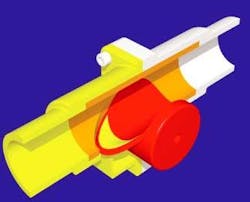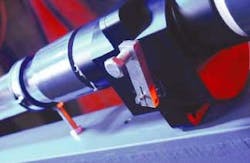Fluma is in the throes of organizing a number of projects to further develop its novel valve technology for offshore application.
The patented technology is based on a new concept, the first time for many years that a genuinely new type of valve has come onto the market, according to managing director Øyvind Espeland. The concept uses the forces of nature. When there is a significant change in the velocity of the flow, the valve is activated. Activation uses the same principles that enable an aircraft to lift off from the ground when the airflow over the wings reaches a certain speed. The valve is like a flap lying flat against the floor of the pipe, to which it is hinged at the downstream end. It is wing-shaped, so that when the flow over it reaches a critical velocity, the upstream end lifts up. The flow then pushes it into an upright position, in which it blocks the pipe.
Among the benefits of this technology is the fact that there is no sensor or actuator that might malfunction or require maintenance. In the case of safety valves on an offshore platform, that means in some cases the absence of an actuator weighing several tonnes and standing several meters high. Another advantage is that the presence of the Fluma valve does not lead to a pressure drop in the pipe, as is the case, for example, with a spring-loaded piston safety device.
null
The prototype Fluma valve used in qualification testing.
null
The technology was qualified for use in a low-pressure gas or liquid flow in trials held at the University College of Stavanger in 2002. The company is now engaged in developing it further for application in both low-pressure and high-pressure pipelines, and in multiphase flows. The development work so far has concentrated mainly on gas, but the technology is applicable to all kinds of media.
As a small start-up company with only six employees, Fluma would like to find either a large partner, such as a main contractor, or a buyer with the financial and marketing muscle to take the product on. While the search goes on, it is promoting the further development of the technology through joint industry projects. It has also teamed up with three partners: Schuck Armaturen of Germany, a valve designer and manufacturer, which has offshore customers among its deliveries; Icarus of Belgium, which specializes in unusual and difficult valve applications, and Blackhall Engineering of the UK, which helps with the design of conceptual prototypes. Fluma's relationship with Blackhall is particularly close, as Blackhall's managing director, James Blackhall, is also a part-time technical director of Fluma.
Gas distribution systems, which include both high-pressure transmission at around 80 bar and low-pressure distribution below 20 bar, are one obvious area of application for the Fluma technology, and the company has been in contact with many operators of such systems. It recently took a significant step forward when it signed a collaboration agreement with Gaz de France under which the technology will be verified at higher pressures than in the HiS trials and its application in the French distribution system will be assessed.
In conjunction with Statoil, which is keen to explore the potential of the technology, Fluma is now looking for a "demanding customer" – one with a clear application requirement – for a high-pressure application, probably in onshore transmission. Funding for such a project has already been arranged with the Norwegian government. Once the valve's applicability in this area has been proven, the next step will be to move into the area of offshore gas transmission, which involves pressures of around 170 bar, Espeland says.
The company is also seeking to set up a HP project together with Icarus, which would be responsible for building the prototype. This again is likely to be in the area of onshore transmission.
Another company keen to test the technology is BP, which is seeking both to identify a suitable project – which might or might not involve an offshore application – and arrange funding.
Offshore applications such as high-pressure multiphase flows represent the most difficult end of the scale. Espeland foresees a phased approach to these challenges, starting with an application relying purely on the valve's use of the forces of nature. In a second stage intelligence could be added to the system, for example to ensure that a device installed in a multiphase pipeline was not wrongly triggered.
Some work has already been done in this area with Norsk Hydro, involving use of the valve as a safety device for processing equipment. The valve would be positioned upstream of the choke controlling the flow of the wellstream into the processing equipment – in the case of choke collapse and loss of control of the flow, the valve would be activated, preventing damage to the processing equipment. Hydro now wants to transfer further work from its own R&D department to a license that would benefit from applying the technology.
By 2006, Fluma aims to have completed development of the technology. If its potential is borne out, it could lead to significant changes in the valve market, replacing ball valves and actuators to a large extent. In the HP area, it could offer an alternative to today's high-integrity pressure protection systems (Hipps).
The technology can also be used in conjunction with other types of valve. After completing a development project for a combi- nation ball valve/Fluma valve for Gasnor, a Norwegian gas distributor, Fluma has received an order to supply the company with 30 such systems. Here, the Fluma valve is installed inside the ball valve. In the event of an accident, the Fluma valve activates automatically, after which the ball valve is manually closed.





